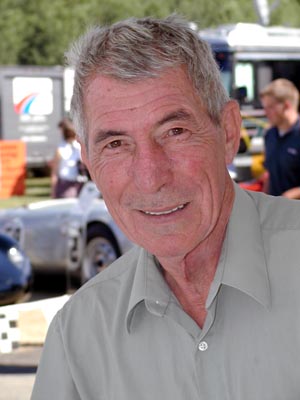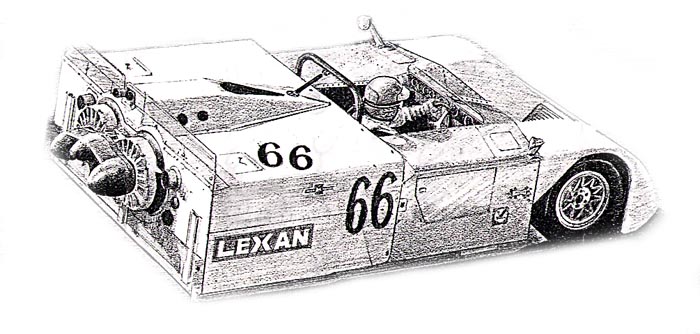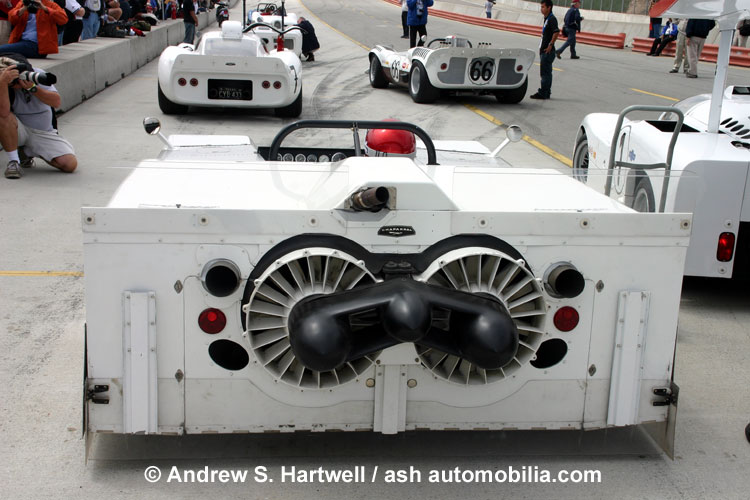This was my "Through The Esses" column in All Race Magazine Issue 29.

Vic Elford And The Vacuum Cleaner
© Andrew S. Hartwell
Among the many legends of motor racing there stands two
men, working on opposite sides of the Atlantic ocean, who
brought innovation to the race track time and again. In Europe,
that man was Colin Chapman. His work with the Lotus Grand
Prix cars saw radical changes with each new season and his
cars were successfully campaigned by such legendary drivers
as Jimmy Clark and Graham Hill.
On the American side of the ocean, a tall Texas oilman and
student of engineering by the name of Jim Hall was also
bringing some innovative and radical thinking to the sportscar
scene. His Chaparral creations were the first to introduce
effectively designed air dams and spoilers ranging from the
tabs attached to the earliest 2C model to the driver-controlled high wing 'flipper' on the astoundingly different looking 2E, all the way through to his most idealistically inspired creation, the 2J. This is the car that would forever be known as the 'vacuum cleaner'.
Introduced in 1970, making its race debut at the Watkins Glen Can-Am race at the hands of world champion Jackie Stewart, the 2J had no precedent to compare it to. It was an angular car at the front and just a big box at the back. And the back was a place that housed two large 17-inch fans driven by a JLO - Rockwell 45 hp snowmobile engine. The fans purpose was to literally 'suck' the air from under the car and shoot it out the back. They acted like reverse fans pulling air through and then out, thus giving the car amazing grip.
The entire car was fitted with a 'skirt' made of a then-new material called Lexan. Plastic-like in construction, the skirt acted as a windbreak allowing the fans to pull out the air thus sucking the car onto the pavement. The amount of grip delivered by the twin fan units was so incredibly high that cornering speeds could be reached that no one else could ever hope to match in a more conventionally designed car.
The 2J represented both the latest in aerodynamic subterfuge and a threat to the sanctity of the motor racing establishment that existed at the time. It could really 'go' on the track, but there were those who just wanted it to 'go away'.
The car only ran for one glorious season (1970) and like all new cars it had it's share of teething pains. Unfortunately it never had a chance to grow up as the sanctioning body, with more than a bit of prodding from the Chaparral's competitors, decided to outlaw the technology after the season had ended.
While the car had just one incomplete season of racing, it was fortunate to have had two outstanding drivers to race it. After Stewarts initial run, Englishman Vic Elford was hired to bring the car home with a win. Hall had said he needed to find someone who could handle the cornering power of his creation, as he didn't think he could do it himself. To best address his need for a qualified pilot he sought out Elford, who had established himself as one of the best in endurance racing with drives for Porsche at Le Mans and other venues. Elford was not able to bring the car a win in its maiden and final season but the road that leads to the podium was one 'Quick Vic' really enjoyed traveling on.
I had a wonderful conversation with Vic Elford at the Porsche Rennsport Reunion at Lime Rock Park recently. I asked him to tell me of the '70 season and his turn at the controls of the vacuum cleaner car. It is an interesting tale of speed, downforce, resentment and control. Eavesdrop for a minute.
Vic Elford: "I was just trying to remember the first time I drove the Chaparral 2J and I recall it was at Rattlesnake Raceway, Jim Hall's private track. He got me down there for a couple of days to get the feel for it because it was 'different' to drive. The first time I raced it was at Road Atlanta (in the Can-Am Championship) when I was about 2.5 seconds quicker than Denny (Hulme) for pole position. Then I drove it at Laguna Seca and again at Riverside.
"Do you remember the old Riverside turn 9? It was a long, long, long fast 180-degree right-hander just before the pits. During practice I came up behind Denny (in the McLaren M8D-Chevrolet) on the way into that corner and it was a very fast corner. Not quite flat but for me very close to it, and I remember driving around the outside of Denny (laughing) and he just pulled off into the pit lane absolutely pissed off! He took his helmet off and sat on the pit wall and sulked for the rest of the practice session. I had beaten his time by about 2.5 seconds. It was a wonderful car to drive!
Tell me about the cars automatic transmission: "It was a semi-automatic transmission, it wasn't fully automatic. It had a three-speed transmission with a torque converter and a lock-up at 5,000 rpm. It was quite complicated to get it running. The steering column went down between your two feet so the left foot could only work the brake and the right foot could only work the gas pedal.
Was driving a car set up that way something of a shock to you? "By sheer luck, really, a year earlier I had a bad accident at the Nurburgring in the Grand Prix, which destroyed my shoulder. I was in physical therapy for weeks, suffering day after day. At that time, Grand Prix drivers all used to have a complimentary car from the FORD motor company in Great Britain. We could have what we liked and, as I had a wife and a couple of kids then, I had a big Zodiac, which was the top of the line sedan in England. The car was an automatic and I had never had an automatic car before so while I had it I thought I'll learn to brake with my left foot.
"I had never done it before so it took me about three months to really learn to do it efficiently. Now I do it automatically every time I get in a car with an automatic transmission. I always break with my left foot now. I wasn't doing it in anticipation of the ride in the Chaparral; I just decided I was going to learn how to do it. When it came time to drive the 2J of course, I was ready for it, as I had no trouble with it.
Did the cars transmission put you at a disadvantage at the start? "At Road Atlanta, Denny Hulme was in the first McLaren and Peter Gethin was in the second one and they all blew me away at the start. I remember that, at 5,000 rpm's the transmission dogs would just lock up. From there on it was solid drive and that went all the way up to 7,600 rpm, which was about maximum in those days. One of the problems was we only had three speeds while the McLaren's and the Lola's all had four speeds. So it didn't matter where I was on the pole because two or three cars would just blow me away at the start.
"We went around to turns 6 to 7, not really an overtaking place, and I followed Peter through turn 6 and as we were sort of half way to turn 7 he was braking. I thought now that's a shame, he must have some sort of problem. And I went past him on braking and then I did the same to the other cars in front on the subsequent laps and it dawned on me that they didn't have a problem; they just couldn't brake where I could! It was a great feeling (laughing).
"The amazing thing about it was that it didn't rely on aerodynamics so it worked as well on slow corners as it did on fast corners. Where as with the McLaren, of course, the faster you go the more downforce you have so they were great in fast corners but just normal in slow corners.
Were the fans on all during the race? "The fans were on all the time. The start up procedure was I had to sit with my foot on the brake because once they started up the two-stroke fans they could actually move the car forward. Not quickly, but it would start creeping forward. I had to put the transmission in first gear then start the main engine and it would just sit there on the torque converter. As soon as I took my foot off I could accelerate away.
"I once did the Acropolis rally with a FORD Lotus Cortina that had no clutch for two thirds of the race. I was pretty good at changing gears without using a clutch and you had to do that in the Chaparral as well. It meant I had to synchronize the revs from first to second and second to third and then back down through the box too. And you have to do this corner after corner.
"The moment the little snowmobile engine started it ran at a pretty constant 5,000 rpm, I think- the car then sucked itself down about two inches with the Lexan skirt scrapping the ground. I didn't finish at Riverside because the little engine broke going through turn 9 - the long fast corner - and the car was perfect until it suddenly came up two inches! That moved the tires up to where you no longer had 18 inches of rubber on the road you had about three inches! Very exciting!
What put an end to the 2J? "The one single guy who really killed the technology of the 2J was Teddy Mayer, the team boss at McLaren - and a lawyer in the bargain. The Can-Am had been exclusively the property of the McLaren for what, three years or so, and so he could see all the money going away and so basically he killed it. And I think the SCCA was weak in not standing up to him really."
If it hadn't been banned? "Everybody would have followed suit, at least in Can-Am. And I think it would have probably lasted several years and then there would have been a reevaluation of the rules to level the playing field and trying to cut the speeds down, because the 2J was the start of really high cornering speeds."
Before Hall built the 2J, another white but supposed-to-be-wingless Chaparral had come off the drawing board. It was the ill-fated 2H. Dubbed the 'white whale' for it's unusually narrow and long shape - a shape made all the more ugly when a huge wing was mounted in the middle of the car in an attempt to counteract undesirable aerodynamic effects - the car never got sorted out and soon made way for the 2J. But the 2H was one more historic marker placed on the trail of sportscar racing.
While Jim Hall and Vic Elford were partners in bringing a radical idea to fruition with the 2J, it seems not everyone loves a winner. But there were a few wonderful days in the sun for Elford and Hall, and the Chaparral cars did run like the desert birds for which they are named. Too bad there had to be a Coyote waiting in the tumbleweeds.


Vic Elford was reunited with the Chaparral 2J at the
32nd Rolex Monterey Historics in August of 2005.
Yes, he took her out for a spin!

Updated: 1/13/2009


